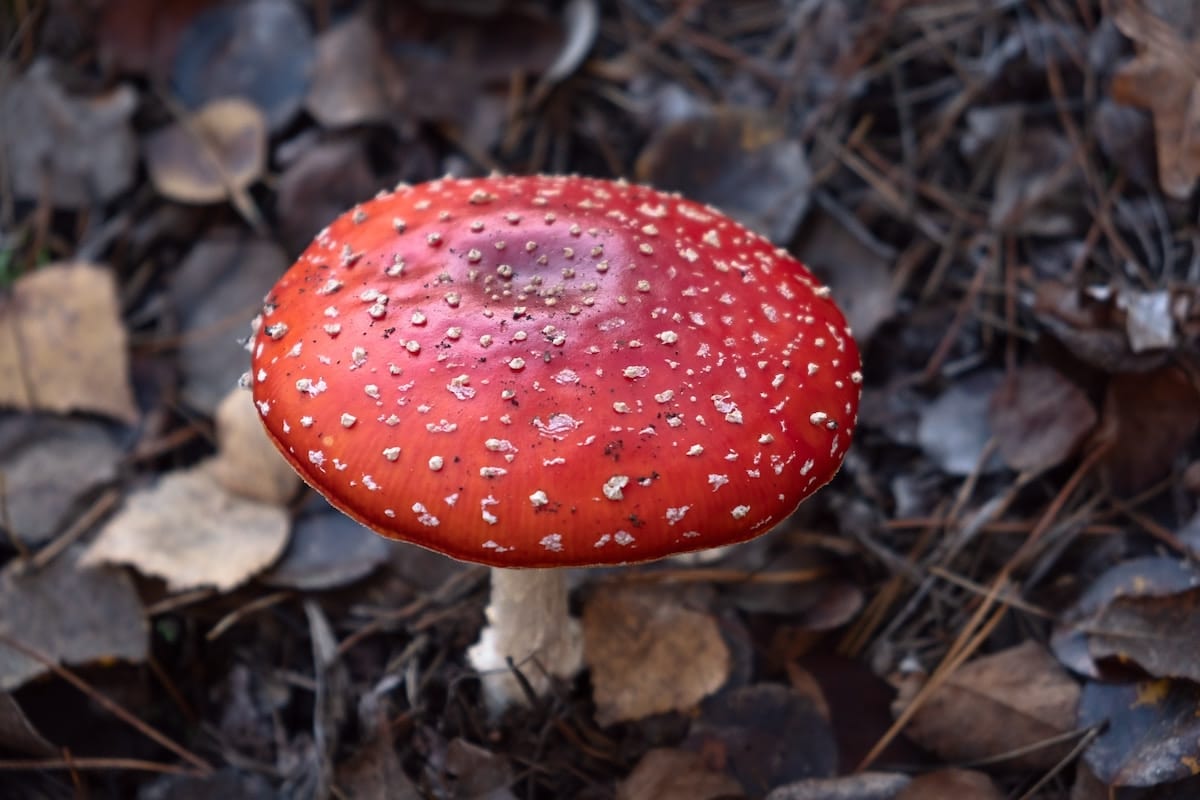Table of Contents
Amanita Muscaria, or fly agaric, is a fascinating mushroom species.
Its vibrant red cap with white spots captivates the imagination and has become the iconic image of countless folktales, fairy tales, and emojis throughout history. However, this enchanting mushroom offers more than just its whimsical appearance. Its intricate structure houses potent compounds that researchers are exploring for health advantages.
From Amanita’s traditional use in shamanic rituals to its potential therapeutic properties, this potent mushroom inspires curious minds to delve into its depths.
Understanding the Compounds of Amanita Muscaria
The effects of Amanita Muscaria can be described as “psychoactive” with qualities distinct from the classic “magic mushrooms.”
Magic mushrooms contain psilocybin as their main hallucinogenic compound, while Amanita mushrooms contain Ibotenic acid, muscimol, and muscarine. Each of these has distinct characteristics. Some are toxic at high doses.
Here’s a closer look:
- Muscimol: Muscimol stands out from its counterparts. It exhibits potent psychoactive properties at high doses and is often the subject of interest for potential therapeutic uses. According to the latest research, muscimol is also the most well-tolerated Amanita compound.
- Ibotenic Acid: Ibotenic acid is also a powerful psychoactive compound. However, it can act as a neurotoxicant, impairing the brain’s normal functioning and causing changes in perception, cognition, and consciousness. These alterations in brain activity can lead to confusion and difficulty coordinating movements.
- Muscarine: Muscarine in Amanita mushrooms exists in minimal concentrations and primarily affects muscarinic acetylcholine receptors, leading to symptoms like salivation and slowed heart rate. Its toxicity can be severe, causing gastrointestinal distress and, in extreme cases, respiratory issues.
Amanita muscaria poisoning is relatively rare, but it can happen. This risk is why most commercial Amanita products are muscimol extracts without ibotenic acid or muscarine.
Health Advantages
Muscimol is not just an Amanita muscaria substance with psychoactive effects; it also has a healing side, showing promise in treating stress, insomnia, and pain. Its versatility makes it a hot topic for those interested in new mental and physical well-being approaches.
Sleep Aid
Muscimol offers notable benefits as a sleep aid, particularly in enhancing the quality of REM or dream sleep. It achieves this by activating the brain’s GABA-A receptors responsible for inhibitory neurotransmission.
As a GABA-A activator, muscimol enhances the effects of GABA, a neurotransmitter responsible for inhibitory functions. GABA suppresses excitatory nerve signals, promoting an overall state of relaxation and reduced neural excitability.
In this calm state, REM sleep becomes more accessible, leading to better sleep quality. REM sleep is also crucial for mental and physical rejuvenation, thus amplifying mental clarity, mood, memory, and physical performance. Therefore, the chain reaction initiated by muscimol’s interaction with GABA-A receptors directly contributes to improved REM sleep.
Pain Relief
Muscimol also has potential analgesic properties. Through its interaction with GABA receptors, muscimol can modulate pain perception. This presents possible relief for various types of pain, such as headaches, muscle aches, and neuropathic pain. In particular, it may be beneficial for individuals with chronic pain. Worldwide, chronic pain is an epidemic, affecting 1.5 billion people.
Neuropathic pain is another severe and pervasive problem.
One in 20 people worldwide experience neuropathy, a type of chronic pain caused by damage or dysfunction of the nervous system. Research suggests that muscimol can effectively ease neuropathic pain by influencing specific receptors in the nervous system.
Anxiety and Mood Enhancement
Generalized anxiety disorder, panic disorder, and major depressive disorder affect many people in today’s fast-paced society. Muscimol addresses this issue by amplifying GABA receptors and soothing the nervous system to regulate mood.
Beyond symptom relief, muscimol’s mood-stabilizing potential could offer a more sustained, long-term benefit for those suffering from chronic emotional imbalances. Its interaction with GABA pathways may also reduce the frequency and severity of mood swings, creating a more stable emotional landscape.
By regulating neurotransmission, muscimol could potentially complement existing therapies for mood disorders, offering a holistic approach to mental wellness.
Dosing: High Versus Low
Recognizing the difference between high and low dosages of muscimol extracts is critical to therapeutic use. Lower doses of this mushroom offer health benefits without the psychoactive potential. Experts recommend a low dose not exceeding two milligrams.
In contrast, higher doses ranging from 8 to 15 milligrams can induce strong hallucinogenic effects.
Side Effects, Dangers, and Potential Risks
Despite its health advantages, Amanita Muscaria has risks. Ibotenic acid and muscarine can be toxic and dangerous at high doses. Consuming raw Amanita mushrooms with these compounds can be hazardous. Possible side effects include nausea, vomiting, confusion, and, in severe cases, seizures. Therefore, it’s essential to approach Amanita Muscaria with respect and seek high-quality muscimol extracts wherever possible.
Final Thoughts
Amanita Muscaria is a fascinating fungus, and muscimol offers many potential health benefits. This mushroom serves as a reminder of nature’s incredible power to heal and optimize health.


